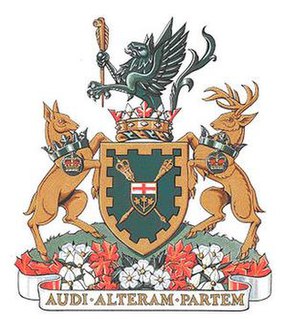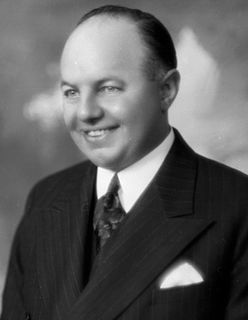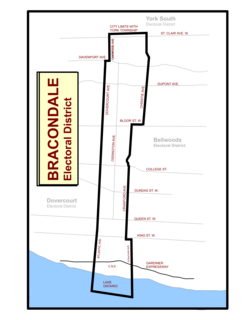A Member of Provincial Parliament (MPP) is an elected member of the Legislative Assembly of the Province of Ontario, Canada.

The Legislative Assembly of Ontario is one of two components of the Legislature of Ontario, the other being the Lieutenant Governor of Ontario. The Legislative Assembly is the second largest Canadian provincial deliberative assembly by number of members after the National Assembly of Quebec. The Assembly meets at the Ontario Legislative Building at Queen's Park in the provincial capital of Toronto.

Ontario is one of the 13 provinces and territories of Canada and is located in east-central Canada. It is Canada's most populous province accounting for 38.3 percent of the country's population, and is the second-largest province in total area. Ontario is fourth-largest jurisdiction in total area when the territories of the Northwest Territories and Nunavut are included. It is home to the nation's capital city, Ottawa, and the nation's most populous city, Toronto, which is also Ontario's provincial capital.
Contents
The titular designation "Member of Provincial Parliament" and the initialism "MPP" were formally adopted by the Legislature on April 7, 1938. Prior to the adoption of this resolution, members had no fixed designation. Prior to Confederation members of the Legislative Assembly of the Province of Canada had been known by various titles including MPP, MLA and MHA and this confusion persisted after 1867 with members of the Ontario legislature using the titles Members of the Legislative Assembly (MLAs) or Members of Provincial Parliament (MPPs) interchangeably. [1]
A title is one or more words used before or after a person's name, in certain contexts. It may signify either veneration, an official position, or a professional or academic qualification. In some languages, titles may be inserted between the first and last name. Some titles are hereditary.
The Legislative Assembly of the Province of Canada was the lower house of the legislature for the Province of Canada, which consisted of the former provinces of Lower Canada, then known as Canada East and later the province of Quebec, and Upper Canada, then known as Canada West and later the province of Ontario. It was created by The Union Act of 1840. Canada East and Canada West each elected 42 members to the assembly. The upper house of the legislature was called the Legislative Council.
In 1938, Frederick Fraser Hunter, the Member for St. Patrick, introduced a private member's bill to designate members as Members of Parliament (MPs) arguing that the titles of MPP or MLA were confusing, inaccurate, and undignified. However, his original proposal failed to pass and as an alternative a resolution was adopted fixing the title as Members of Provincial Parliament (MPP). [1]
A private member's bill in a parliamentary system of government is a bill introduced into a legislature by a legislator who is not acting on behalf of the executive branch. The designation "private member's bill" is used in most Westminster System jurisdictions, in which a "private member" is any member of parliament (MP) who is not a member of the cabinet (executive). Other labels may be used for the concept in other parliamentary systems; for example, the label member's bill is used in the Scottish Parliament and in the Parliament of New Zealand. In presidential systems with a separation of the executive from the legislature, the concept does not arise since the executive cannot initiate legislation, and bills are introduced by individual legislators.
The text of the resolution passed by the House on that day is as follows:
In law, resolution is a written motion adopted by a deliberative body. The substance of the resolution can be anything that can normally be proposed as a motion. For long or important motions, though, it is often better to have them written out so that discussion is easier or so that it can be distributed outside the body after its adoption. An alternate term for a resolution is a resolve.
On motion of Mr. Hunter, seconded by Mr. Miller,
Resolved, That in all matters of address, titular distinction, formal correspondence, official proceedings and all similar matters having to do with and coming under the jurisdiction of the Legislature of Ontario, the members of the Legislative Assembly shall be entitled to the designation "Member of Provincial Parliament" and its abbreviation "M.P.P." [2]
Ontario is the only Canadian provincial legislative assembly to employ this designation. Members of other Canadian provincial and territorial assemblies employ the titles:
- "Member of the National Assembly" (MNA) in Quebec,
- "Member of the House of Assembly" (MHA) in Newfoundland and Labrador
- "Member of the Legislative Assembly" (MLA) in all other provinces and territories.

The National Assembly of Quebec is the legislative body of the province of Quebec in Canada. Legislators are called MNAs. The Queen in Right of Quebec, represented by the Lieutenant Governor of Quebec and the National Assembly compose the Legislature of Quebec, which operates in a fashion similar to those of other Westminster-style parliamentary systems.

Quebec is one of the thirteen provinces and territories of Canada. It is bordered to the west by the province of Ontario and the bodies of water James Bay and Hudson Bay; to the north by Hudson Strait and Ungava Bay; to the east by the Gulf of Saint Lawrence and the province of Newfoundland and Labrador; and to the south by the province of New Brunswick and the U.S. states of Maine, New Hampshire, Vermont, and New York. It also shares maritime borders with Nunavut, Prince Edward Island, and Nova Scotia. Quebec is Canada's largest province by area and its second-largest administrative division; only the territory of Nunavut is larger. It is historically and politically considered to be part of Central Canada.
House of Assembly is a name given to the legislature or lower house of a bicameral parliament. In some countries this may be at a subnational level.
"MPP" was the titular designation of the members of the Legislative Assembly of Lower Canada from 1791 to 1838.






